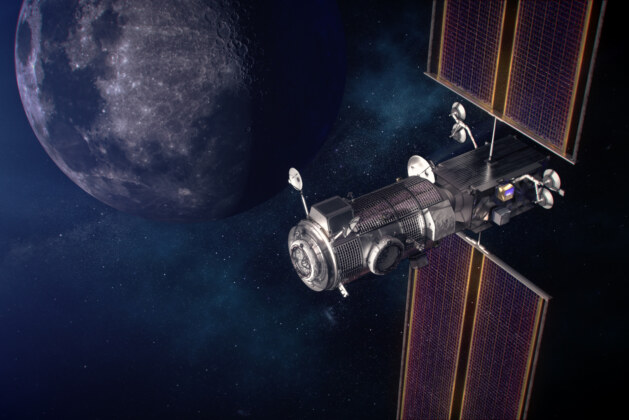If you’ve ever wondered how astronauts will travel back to the Moon or eventually head to Mars, the Lunar Gateway is your answer. This ambitious space station, set to orbit the Moon, promises to be a cornerstone of humanity’s future in space exploration. But what exactly is it, and why should we care? Buckle up, because we’re about to take a trip to the future of space exploration!
Table of Contents
What is the Lunar Gateway?
Think of the Lunar Gateway as a pit stop in space—except it’s a really cool pit stop. The Lunar Gateway is a planned space station that will orbit the Moon, providing a crucial platform for astronauts to prepare for missions to the Moon’s surface and beyond, including Mars. Developed by NASA in collaboration with international space agencies (like the European Space Agency, ESA, and Japan’s JAXA), the Gateway is designed to support long-term human presence on the Moon and act as a launch point for deeper space missions.
It’s not a moon base or a tourist hub (yet). Instead, think of it as a super-advanced version of the International Space Station (ISS), but with a Moon-sized upgrade. It will offer astronauts a place to live, work, and even perform science experiments—all while orbiting 239,000 miles from Earth.
Why Do We Need the Lunar Gateway?
Good question. After all, the Moon isn’t exactly a short drive away. So why go through the effort of building a space station in lunar orbit? There are a few reasons why the Lunar Gateway is so important for the future of space exploration:
1. A Launch Point for Lunar Missions
The Gateway will act as a hub for astronauts to launch from before heading to the Moon’s surface. Without it, astronauts would need to travel all the way to the Moon’s surface from Earth, which sounds tiring and inefficient (not to mention costly). By creating a staging point in lunar orbit, we reduce the travel time and complexity involved in landing on the Moon.
2. A Stepping Stone to Mars
The Gateway isn’t just about lunar exploration; it’s also a key part of NASA’s larger goal: sending humans to Mars. Just like the Moon served as a stepping stone for human exploration of space in the 1960s and ’70s, the Lunar Gateway will help prepare us for longer journeys. Its technologies, life-support systems, and deep space capabilities will be tested here before they are needed for Mars missions.
3. International Cooperation
The Lunar Gateway will be a collaborative effort between NASA and international partners. Space exploration is a huge undertaking, and by working together, we can share resources, knowledge, and expertise. The Gateway is a symbol of global cooperation—because when you’re out in the cold void of space, it’s nice to know you’ve got backup!
4. Sustaining Human Life in Space
One of the biggest challenges of space exploration is how to keep astronauts alive for extended periods. The Lunar Gateway will allow for the testing of life-support systems that can sustain astronauts for long durations, while also providing essential resources like water, oxygen, and power. If we can make it work on the Moon, we’ll be one step closer to making long-term space travel a reality.
How Will the Lunar Gateway Work?
The Lunar Gateway isn’t just a floating space station—it’s an extremely advanced hub, equipped with state-of-the-art tech designed to make deep space exploration feasible. Here’s a rundown of how it’s going to work:
1. Orbits the Moon, Not Lands on It
Unlike the ISS, which orbits Earth at a relatively low altitude, the Lunar Gateway will orbit the Moon at a distance of about 3,000 to 4,000 miles. This “halo orbit” is a unique path that keeps the station in a stable position, making it an ideal launching point for Moon missions. It’ll also be positioned in a way that ensures minimal interference from the Moon’s gravity—making it easier for astronauts to come and go.
2. Modular Design
The Lunar Gateway will be modular, meaning different pieces of the station will be added over time. This will allow NASA to test out various systems and expand the Gateway as new technologies are developed. Think of it like a space IKEA project: build it, test it, tweak it. Over time, the station will grow into a fully functional outpost for astronauts to live and work.
3. Power & Propulsion
Powering the Gateway won’t be as simple as plugging it into a socket (if only!). Instead, it will rely on solar power—using large solar arrays to gather energy from the Sun. The station will also have a powerful propulsion system that will allow it to adjust its orbit as needed, ensuring it stays in the optimal position for lunar missions.
4. Docking Ports for Spacecraft
Astronauts, rovers, and supplies will need a place to dock with the Lunar Gateway, and that’s where the docking ports come in. These will be used for spacecraft (like NASA’s Orion) to deliver crew and cargo to the station. These ports will also facilitate travel to and from the Moon’s surface, as well as provide a safe place for spacecraft to wait before embarking on deeper missions.
The Future of Lunar Gateway: What’s in Store?
As we look toward the future, the Lunar Gateway is more than just a cool space station. It represents humanity’s next giant leap in space exploration. Over the next few decades, we can expect the following:
1. Human Missions to the Moon
NASA’s Artemis program will take the first astronauts back to the Moon, and the Lunar Gateway will serve as their home base. Imagine living and working in a place where you’re constantly reminded of the Earth’s beauty—and its distance.
2. Space Tourism (Maybe?)
While it’s not likely to happen in the immediate future, the Lunar Gateway could one day be part of the space tourism industry. Picture this: sipping a space cocktail while orbiting the Moon. Okay, maybe we’re getting ahead of ourselves, but it’s not entirely impossible.
3. The Moon as a Test Bed for Mars
Everything tested at the Lunar Gateway will be part of the plan for Mars. The Gateway’s life-support systems, habitats, and even propulsion systems will be key to making long-duration space missions a reality.
4. International Presence
The Lunar Gateway will be a space where astronauts from various countries can come together to live and work. This could lead to a truly international collaboration in the race to explore space—and a more united front in the pursuit of scientific discovery.
Conclusion: The Lunar Gateway is the Future
The Lunar Gateway is not just a space station; it’s a launchpad for humanity’s future in space. It will help us return to the Moon, lay the groundwork for missions to Mars, and foster international cooperation in space exploration. Plus, it’s a pretty cool project to get excited about. After all, how often do you get the chance to be part of something that will go down in history as a stepping stone to humanity’s presence beyond Earth?
So, the next time you look up at the Moon, remember: there’s a new neighbor up there, and it’s a pretty stellar place to start our journey to the stars.
Read More: Aerospace Materials: The Foundation of Modern Aviation and Space Exploration





Your blog post was exactly what I needed to hear today. Thank you for the gentle reminder to practice self-care.